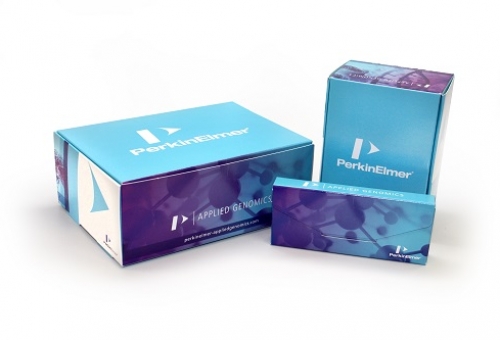
NEXTFLEX® PCR-Free Barcodes
Up to 24 multiplexed samples (up to 192 reactions per kit)
Compatible with NEXTFLEX® PCR-Free DNA Sequencing Kit
Compatible with Illumina® Next-Generation Sequencing platforms
- 产品简介
- 试剂组分
- 引用文献
Pool Multiple Library Preparations in a Single Flow Cell Lane
NEXTFLEX® PCR-Free Barcodes are barcoded adapters for multiplexing Illumina® libraries which provide flexibility and high-throughput capabilities in sequencing applications. They significantly increase scale while reducing costs by allowing the user to pool multiple library preparations in a single flow cell lane. The NEXTFLEX® PCR-Free Barcodes accomplish this by using an indexed adapter with a 6 nt unique sequence. This allows for proper differentiation between samples, preventing poor reads caused by single base errors introduced during PCR. The NEXTFLEX® index is contained within the adapter sequence, eliminating the need to perform PCR to add flow cell binding sequences. These barcodes can be used with single, paired-end, and multiplex reads and are compatible with the NEXTFLEX® PCR-Free Sequencing Kits and other PCR-Free DNA library prep protocols.
产品特点:
6 nt index contained within adapter sequence eliminates the need to perform PCR to add flow cell binding sequences
Up to 24 multiplexed samples (up to 192 reactions per kit)
Compatible with NEXTFLEX® PCR-Free DNA Sequencing Kit
Considerably reduce your per-sample sequencing cost by barcoded multiplexing
Increase your sequencing scale by pooling 100s of samples on a single flow cell
Compatible with Illumina® Next-Generation Sequencing platforms
产品列表:
| 货号 | 产品名称 | 规格 |
| NOVA-514110 | NEXTFLEX® PCR-Free Barcodes-6 | 48 RXNS |
| NOVA-514112 | NEXTFLEX® PCR-Free Barcodes-24 | 192 RXNS |
KIT CONTENTS
NEXTFLEX® PCR-Free Barcode Adapter (50 µM)
Bartoli, C., Carrere, S., Lamichhane, J. R., Varvaro, L. and Cindy E. Morris, C. E. (2015) Genome Sequencing of 10 Pseudomonas syringae Strains Representing Different Host Range Spectra. Genome Announc. 3: e00379-15.
Chusova, O, et al. (2014) Effect of pine bark on the biotransformation of trinitrotoluene and on the bacterial community structure in a batch experiment. Ecological Technology. Vol. 35, Issue 19.
Chusova, O. et al. (2015) Biotransformation of pink water TNT on the surface of a low-cost adsorbent pine bar. Biodegradation. 1 – 12.
Evrony, Cai, et al. (2012) Single-Neuron Sequencing Analysis of L1 Retrotransposition and Somatic Mutation in the Human Brain. Cell. Vol. 151, Issue 3, pp. 483-496.
Hasbún, R., Iturra, C., Bravo, S., Rebolledo-Jaramillo, B. and Valledor, L. (2016) Differential Methylation of Genomic Regions Associated with Heteroblasty Detected by M&M Algorithm in the Nonmodel Species Eucalyptus globulus Labill. International Journal of Genomics. 4395153. doi: 10.1155/2016/4395153.
Kawahara-Miki R., Sano S., Nunome M. et al. (2013) Next-generation sequencing reveals genomic features in the Japanese quail. Genomics. DOI: 10.1016/j.ygeno.2013.03.006.
Kocher, A., et al. (2016) Vector soup: high-throughput identification of neotropical phlebotomine sand flies using metabarcoding. Molecular Ecology Resources. doi:10.1111/1755-0998.12556.
Kofler, R., Nolte, V. and Schlötterer, C. (2015) Tempo and Mode of Transposable Element Activity in Drosophila. PLOS Genetics. doi: 10.1371/journal.pgen.1005406.
Kofler, R., Nolte, V. and Schlötterer, C. (2015) The impact of library preparation protocols on the consistency of allele frequency estimates in Pool-Seq data. Molecular Ecology Resources. doi: 10.1111/1755-0998.12432.
Ligi, T, et al. (2013) Characterization of bacterial communities in soil and sediment of a created riverine wetland complex using high-throughput 16S rRNA amplicon sequencing. Ecological Engineering. DOI: 10.1016/j.ecoleng.2013.09.007.
Mändar, R. et al. (2015) Complementary seminovaginal microbiome in couples. Research in Microbiology. doi:10.1016/j.resmic.2015.03.009.
Mathys J., Vos C. et al. (2013) RNAseq-based transcriptome analysis of Lactuca sativa infected by the fungal necrotroph Botrytis cinerea. Plant, Cell & Environment. DOI: 10.1111/pce.12106.
Mazueta, C., Bouchierb, C. and Popoffadoi, M. R. (2015) Draft Genome Sequence of Clostridium botulinum Strain 277-00 Type B2. Genome Announc. 3:2 e00211-15. doi: 10.1128/genomeA.00211-15.
Petersen, G., et al. (2015) Phylogeny of the Alismatales (Monocotyledons) and the relationship of Acorus (Acorales?). Cladistics. doi: 10.1111/cla.12120.
Sato S, Sesay AK, Holder AA (2013) The Unique Structure of the Apicoplast Genome of the Rodent Malaria Parasite Plasmodium chabaudi chabaudi. PLoS ONE 8(4): e61778. doi:10.1371/journal.pone.0061778.
Smidt, I., et al. (2015) Comparison of detection methods for vaginal lactobacilli. Beneficial Microbes. In press.
Suzuki, S, et al. (2014) Physiological and genomic features of highly alkaliphilic hydrogen-utilizing Betaproteobacteria from a continental serpentinizing site. Nature Communications 5, (3900).
Tiirik, K, et al., (2014) Characterization of the bacterioplankton community and its antibiotic resistance genes in the Baltic Sea. Biotechnology and Applied Biochemistry. Vol. 61, Issue 1, pp. 23–33.
Won, HH, et al. (2013) Detecting somatic genetic alterations in tumor specimens by exon capture and massively parallel sequencing. J. Vis. Exp. (80), e50710, doi:10.3791/50710.








